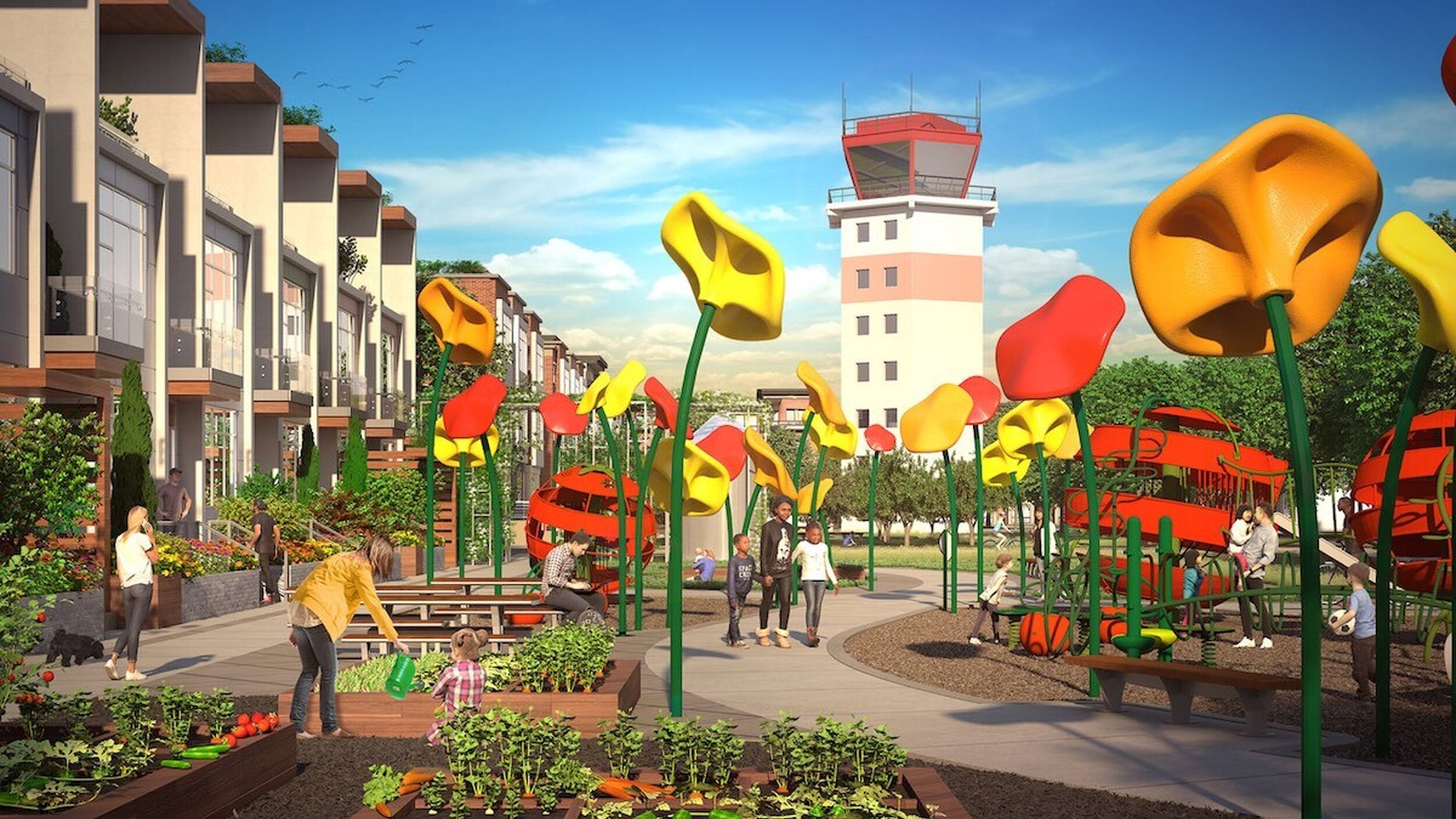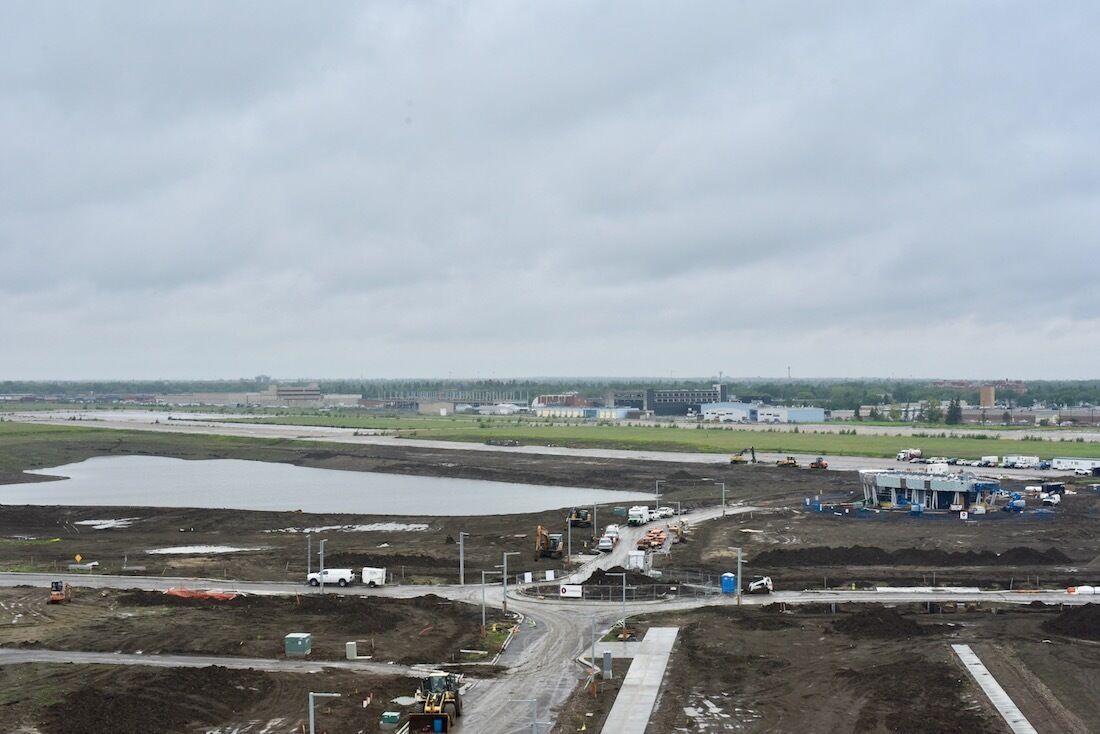
Rendering of the Blatchford redevelopment in Edmonton.
The climate battle of Alberta
Which city is being bolder, Calgary or Edmonton?
This story is part of The Sprawl's Climate Action Edition. It's also part of Covering Climate Now, a global week-long collaboration of 250+ news outlets to strengthen coverage of the climate story.
In Calgary, a certain malaise seems to have infected the population when it comes to action on climate change. Some think the crisis is overblown. Others think the problem is too big to solve, so why bother?
So, to draw inspiration on climate action, we look to another city. Not Vancouver, and no Scandinavian cities—which, yes, are kicking Calgary’s butt on climate action—but instead a city much closer to home.
A city that we as Calgarians can’t stand losing to: Edmonton.
Edmonton Mayor Don Iveson has been vocal on climate action—much more so than Calgary Mayor Naheed Nenshi. In August, Edmonton’s city council joined the growing list of cities to declare a climate emergency. And last year, at the Cities and Climate Change Science Conference in Edmonton, Iveson challenged other mayors to step up.
He asked mayors from cities around the world to sign the Edmonton Declaration—a commitment for cities to do more to fight climate change.
Nenshi did not sign the declaration.
“The mayor generally doesn’t like signing declarations that would commit council to a course of action without getting their input first,” said Nenshi spokesperson Adam Noble-Johnson in an email. (Nenshi declined an interview with The Sprawl for this story.)
“Seeing as we were in the middle of preparing our own climate strategy [at the time], to sign the declaration before that could be presented to council seemed premature.”
Edmonton remakes its inner-city airport
But declarations are just that—declarations. What is Edmonton actually doing?
Standing at the top of a defunct air traffic control tower north of the city's downtown, one looks around and sees mud and the asphalt lines of newly-paved roads.
It doesn’t look like much now, but it’s expected to be the crown jewel in the City of Edmonton’s sustainability strategy: a carbon-neutral neighbourhood for 30,000 people.

Tom Lumsden, the Blatchford community development manager, explains the vision for the old city airport land.
“It was actually a licenced airstrip in 1927, making it the oldest airport in Canada,” he said. “So we’re paying tribute to that with the street names… and our main streets are following the old runways.”
The homes and businesses will be powered entirely by renewable energy, and they will open up onto pedestrian walkways instead of roads. Once complete, city officials believe it will be the largest carbon-neutral neighbourhood in the world—though it will be in the race with a number of other cities clamouring for similar titles.
Nearly 600 geothermal wells, drilled 150 meters down, will provide the bulk of the energy.
More will come from heat exchanges placed in the city’s sewers. The energy will be communally managed through several district energy centres. Solar power is also a consideration for further down the line.
Homes in the Blatchford neighbourhood will be off the grid and won’t have water heaters or furnaces of their own.
The use of district energy sharing systems isn’t new; they are commonly deployed in university campuses and hospitals. There’s even been one developed in Calgary’s East Village.
However, the scale of Edmonton’s project—and its use of renewable energy only—makes it unique.
Using this system means homes in the Blatchford neighbourhood will be off the grid and won’t have water heaters or furnaces of their own. Residents will instead pay fees to the city, which will run the efficient, shared system.
“We are growing the [energy] system as the development grows,” said Christian Felske, the director of renewable energy systems for the city of Edmonton.
Edmonton council drove carbon-neutral vision
Blatchford is the largest renewable project Edmonton has ever taken on. But Felske thinks it will serve as a model to prove what is possible in future developments in the city. They’re working up plans for a similar energy system to be deployed in the downtown core.
“This is huge in the scale of things,” said Felske. “Obviously when we look at the size of the development, the amount of people who are going to be connected to a renewable energy system, this is crucial.”
Both Felske and Lumsden agree that the project would never have gotten off the ground without the will and push for more aggressive climate action by elected leaders.
“This was city council's vision to do this with this land,” Lumsden said.
So far, six parcels of Blatchford land have been sold to developers who will start construction of townhouses and condos. The first residents are expected to move in by early 2020.
Edmonton has the highest per capita emissions among major Canadian cities, with Calgary a close second.
Blatchford is only one piece of Edmonton’s climate action strategy.
Other parts aren’t as flashy. For example, Edmonton is going into year three of its energy benchmarking program for commercial and residential buildings to voluntarily submit to an energy efficiency audit.
Mike Mellross, an energy transition program supervisor for the City of Edmonton, says some buildings saw as much as a 2% drop in energy consumption in a single year after their audit.
Programs like this are not revolutionary, but as buildings account for so much of a city’s emissions—about two-thirds, in Calgary’s case—it’s an important place to start.
The City of Calgary agrees and will soon be following suit in implementing a similar program, according to their Climate Resilience Strategy (read more about that plan here).
Edmonton still has a long way to go. Data submitted by Canadian cities to the Carbon Disclosure Project show that Edmonton has the highest per capita emissions, with Calgary coming in a close second.
However, despite starting at a disadvantage, Edmonton has made climate action a priority.
Calgary Councillor Druh Farrell has spoken repeatedly about the need for stronger climate action from city council.
“We need the mayor’s advocacy, but we need all council to be thinking about this," she said.
Farrell, who was first elected in 2001, says city hall used to be bolder on the issue. She applauds the work done by former Mayors Al Duerr and David Bronconnier, which resulted in wins such as the LRT being run on wind power.
“We had an administration that cared deeply about the topic," she recalled. "We had very visible members of administration who were in front of council helping us make good decisions.”
We had an administration that cared deeply about the topic.… Then we went silent.
“Then we went silent.... And in the meantime we grew an unprecedented amount.”
Farrell is hoping that Calgary’s current climate plan is upheld, even if it isn’t as strong as she’d like it to be.
“The people I talk to who are watching the world events, and the sheer magnitude of record-breaking weather events, are feeling despair,” she said. “And they see us going backwards, not forwards. It's hard to watch."
Sarah Lawrynuik
The Sprawl relies on crowdfunding to do stories like this one. Please consider pitching in. Support independent journalism—become a Sprawl member today!
Support in-depth Calgary journalism.
Sign Me Up!We connect Calgarians with their city through in-depth, curiosity-driven journalism—but can't do this alone! We rely on our readers and listeners to fund our work. Join us by becoming a Sprawl member today!
